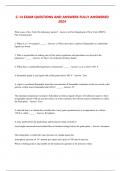C-14 EXAM QUESTIONS AND ANSWERS FULLY ANSWERED
2024
Who issues a New York City laboratory permit? - Answer- d) Fire Department of New York (FDNY)
Fire Commissioner
2. When is a C-14 required? _____ - Answer- c) When more than 1 gallon of flammable or combustible
liquids are stored
3. Who is responsible for making sure all fire safety regulations and procedures are obeyed in the
laboratory? _____ - Answer- b) The C-14 certificate of fitness holder
4. When does a combustible liquid have a flash point? _____ - Answer- a) at or above 100° F
A flammable liquid is any liquid with a flash point below 100° F - Answer- True
A vapor is considered flammable when the concentration of flammable contituants in the air exceeds what
percent of their lower flammable limit (LFL)? _____ - Answer- 25
The minimum temperature in degrees Fahrenheit at which a liquid will give off sufficient vapors to form
an ignitable mixture with air near the surface or in the container, but will not sustain combustion is called
the flash point. - Answer- True
A material that is so chemically unstable that it may ignite spontaneously at a temperature at or below
130°F is called: _____ - Answer- Pyrophoric
A story partly below the grade plane and having less than one-half its
clear height (measured from finished floor to finished ceiling) below the grade plane. - Answer- basement
The temperature at which the vapor pressure of a liquid equals the
atmospheric pressure of 14.7 pounds per square inch (psia) or 760 mm of mercury.
Where a boiling point is unavailable for the material in question or for mixtures which
,do not have a constant boiling point, for the purposes of this classification, the 20-
percent evaporated point of a distillation performed in accordance with ASTM D 86
shall be used as the boiling point of the liquid. - Answer- boiling point
An element, chemical compound or mixture of elements or compounds or
both. - Answer- chemical
The scientific designation of a chemical in accordance with the
nomenclature system developed by the International Union of Pure and Applied
Chemistry (IUPAC), the Chemical Abstracts Service rules of nomenclature, or a name
that will clearly identify a chemical for the purpose of conducting an evaluation. - Answer- chemical
name
A container sealed by means of a lid or other device capable of
preventing the escape of liquid, vapor or dusts in the ordinary course of storage,
handling or use. - Answer- closed container
Any liquid that has a closed-cup flash point at or above
100°F, as determined by the standard test procedures. - Answer- combustible liquid
For solid and liquid hazardous materials, a vessel of 60 gallons or less
in capacity used for storage or transportation. For compressed gases, a container,
pressure vessel or tank designed for pressures greater than one atmosphere at 68°F.
Pipes, piping systems, engines and engine fuel tanks associated with solid or liquid
hazardous materials or compressed gases, shall not be deemed to be containers if in
active use. - Answer- container
A "type II" laboratory includes all of the following features EXCEPT? - Answer- 2-hour fire rated
Compressed gas containers shall be kept away from: - Answer- a) Sources of ignition
,b) Corrosive Chemicals
c) Falling objects
d) All of the above **
Which of the following has the highest hazard rating? - Answer- Class 4
What are the proper color codes for the NFPA Diamond sign? - Answer- Blue, red, yellow
Hazard severity on the NFPA diamond goes from 0 to 4 with 4 being the highest hazard. - Answer- True
14. If a C-14 Certificate of Fitness holder notices there is no fire extinguisher in the laboratory, they
should
immediately notify: _____ - Answer- b) The building owner or designated building employee.
A liquid, solid, or gas that causes permanent injury ("full
thickness destruction") to human skin at a rate specified by the Department of
Transportation (DOT) regulations. Or a liquid that can corrode ¼ inch of steel or
aluminum within the course of a year. - Answer- corrosive materials
The maximum gauge pressure that a pressure vessel, device,
component or system is designed to withstand safely under the temperature and
conditions of use. - Answer- design pressure
The pouring or transferring by other means of any material from a
container, tank or similar vessel, which would release dusts, fumes, mists, vapors or
gases to the atmosphere, unless such release is prevented by a device, equipment or
system designed for that purpose. - Answer- dispensing
What are the FDNY door signage requirements? - Answer- - Laboratory caution: hazardous materials
required at each chemical lab unit
- No smoking signs required at exterior entrances to and inside storage rooms and labs
, - Posted at the entrances where the following are stored and used: radioactive materials, poison gas,
biohazards, reactive materials, flammable gases, explosives
What are the laboratory unit criterias? - Answer- - Minimum 1 hour fire rated
- May include more than 1 separate work areas and other contiguous rooms like offices
- Greater than 1 gallon of combustibles or flammable liquids
- Greater than 75 standard cubic feet of flammable gases
Pre-existing laboratory types (type, fire rating, fire protection) - Answer- - Type I: 2 hours, sprinklers
- Type II: 1 hour, sprinklers
- Type III: 2 hours, no sprinklers
- Type IV: 1 hour, no sprinklers
New laboratory types (type, fire rating, fire protection, fire hazard) - Answer- - Class B: 1/2 hrs,
sprinklers, moderate
- Class D: 1/2 hrs, sprinklers, minimal
Flammable liquids - Answer- - Flashpoint is <37C (100F)
- Includes acetone, ethanol, sigmacote, TEMED
Combustible liquids - Answer- - Flashpoint is 37-93C
- Includes ethylene, glycol, acetic acid, mineral oil
Flammable solids - Answer- - Causes fire through friction, absorption of moisture, or spontaneous
chemical changes
- Includes white phosphorous, sodium and potassium metals, nitrocellulose
Oxidizing materials - Answer- - Yields oxygen readily to support combustion
- Includes permanganate, nitrates, hydrogen peroxide




